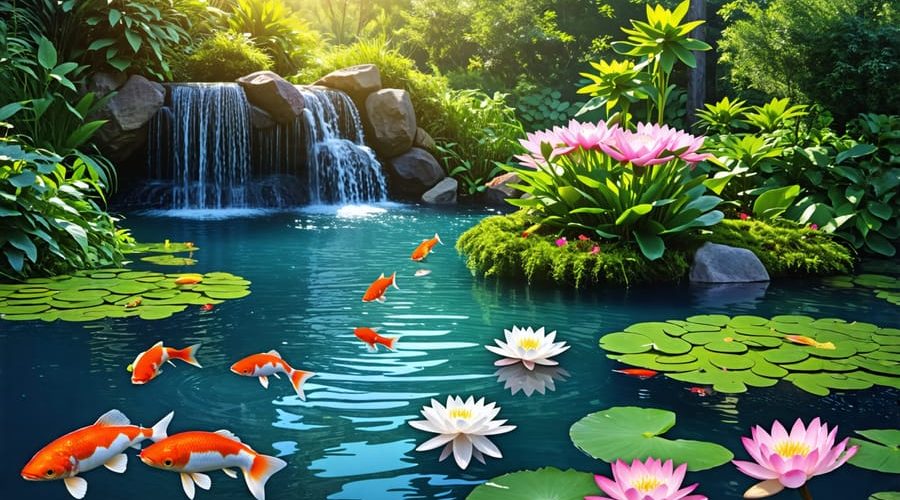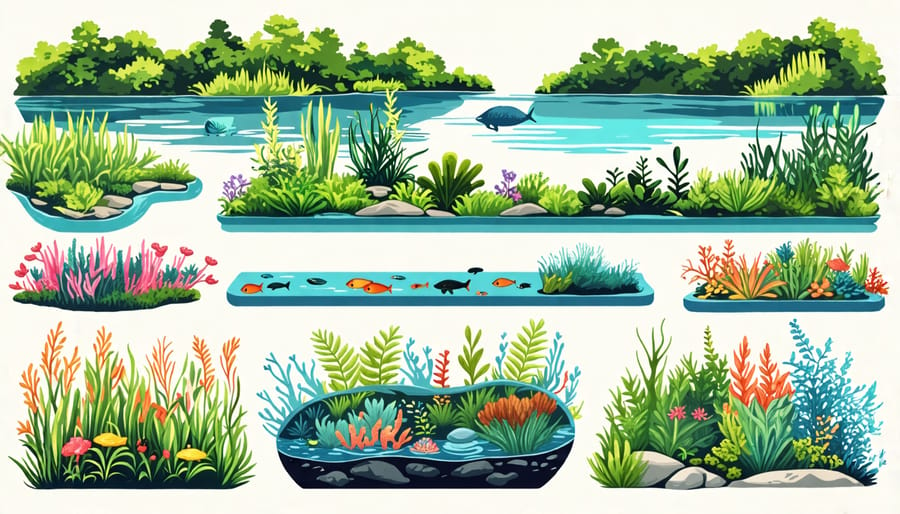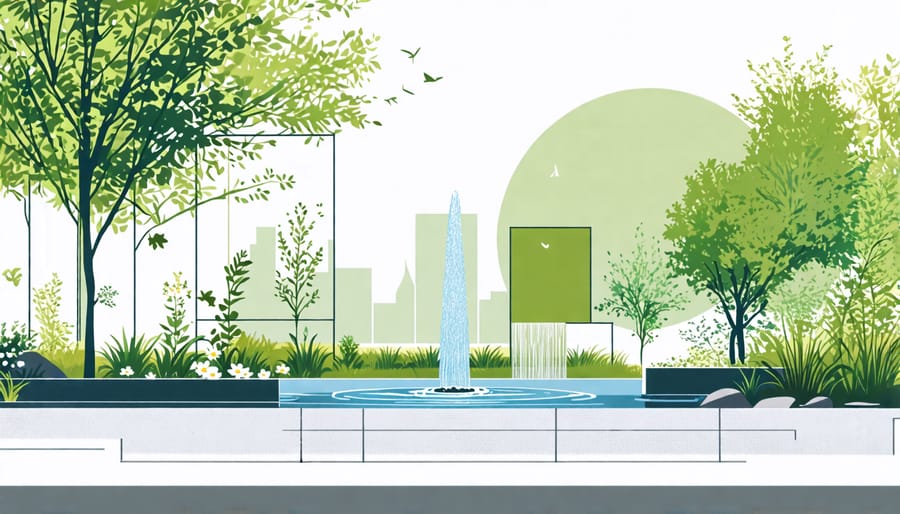
Dive into the Hidden Benefits of Aquatic Ecosystems for Your Water Garden
Transform your water garden by enhancing its ecosystem. Start by introducing native aquatic plants, which filter water naturally while providing habitat for wildlife. Ensure water quality with regular testing and balance nutrient levels using environmentally friendly options, like floating islands, that remove excess nutrients. Foster biodiversity by adding a diverse mix of fish and invertebrates that maintain ecological balance and offer visual interest. Regularly clear debris to prevent algal blooms, and use natural liners to maintain pond health.
What Are Aquatic Ecosystems?
Types of Aquatic Ecosystems
Aquatic ecosystems come in fascinating varieties that intrigue DIY enthusiasts and water gardeners alike. Freshwater ecosystems, such as ponds, streams, and rivers, are often accessible venues for creating serene water gardens at home. These ecosystems support a range of plants and creatures, offering a canvas for nature enthusiasts to craft stunning outdoor spaces. Marine ecosystems, including oceans and seas, might seem daunting to replicate, yet saltwater aquaria emulate their vibrant life. They feature dazzling fish and coral, transforming any room into an underwater spectacle. Then there are man-made ecosystems, like water gardens and koi ponds, which are ideal for those looking to enhance their outdoor aesthetics. Imagine a well-placed water feature surrounded by lush greenery and the gentle sound of moving water—it’s a personalized Eden! By understanding these ecosystems, you can incorporate their elements into your home, creating a sanctuary that’s both beautiful and eco-friendly. Dive in and start your aquatic adventure!

Key Components
Aquatic ecosystems are lively, intricate tapestries woven together by water, plants, and animals, forming a dazzling display of life. At the heart of these ecosystems is water, the lifeline that nourishes the entire environment. Whether in a sprawling lake or a humble garden pond, water creates a dynamic habitat where flora and fauna thrive.
Plants, both submerged and floating, add a lush vibrancy, offering essential services like oxygen production and water filtration. Imagine water lilies gracefully adorning your pond, providing shade and creating micro-habitats for fish. Speaking of fish, these fascinating creatures are vital members of aquatic ecosystems. They maintain ecological balance by controlling algae growth and feeding on pests, making them your natural allies in keeping a healthy water garden.
Together, water, plants, and animals make aquatic ecosystems indispensable. Next time you look at your pond, consider the complex interactions seamlessly at play. These components not only foster biodiversity but also elevate your outdoor space into a serene oasis.
Ecological Benefits of Aquatic Ecosystems
Biodiversity Hotspots
Aquatic ecosystems are truly the vibrant lungs of our planet, supporting an incredible variety of life. Imagine your own backyard water garden teeming with life; now scale that up to lakes, rivers, and oceans filled with countless species of fish, plants, insects, and microscopic organisms. This diverse web of life plays a crucial role in maintaining ecological balance. For pond lovers and water gardening enthusiasts, replicating a slice of this in a home setting enhances not just beauty but also biodiversity. The plants you introduce will attract all sorts of wildlife—from dragonflies and frogs to birds seeking a drink or a bath. Such diversity doesn’t just boost the aesthetic appeal; it helps create a mini-ecosystem that can support a wide array of beneficial organisms. By nurturing your water garden, you do your bit in supporting biodiversity, turning your little aquatic spot into a hotspot teeming with life. So, dive eagerly into cultivating your water garden, knowing you’re contributing positively to the planet!
Water Purification
Aquatic ecosystems are nature’s cleaning crew, filtering and purifying water in ways that are both fascinating and essential for healthy environments. Picture this: rainwater flows through your garden pond, where plants like water lilies and reeds act as natural filters. These plants absorb excess nutrients and pollutants, keeping the water clear and healthy. Meanwhile, tiny microorganisms break down organic matter, effectively removing harmful bacteria and producing breathable oxygen. This process not only benefits wildlife by providing them with a safe habitat but also enhances the aesthetic of your home water garden, creating a vibrant and refreshing space. Whether you’re adding a small fountain or a larger pond, incorporating plants and maintaining a balance can mimic these natural filtration systems at home. Embrace these eco-friendly solutions and enjoy a flourishing aquatic ecosystem right in your backyard, making your outdoor space not just beautiful, but a vital part of the earth’s water purification network.
Enhancing Your Water Garden with Aquatic Ecosystem Principles
Selecting the Right Plants
Choosing the right plants is vital for maintaining a healthy pond ecosystem. The key to success is selecting the right plants that naturally purify and oxygenate the water. Start by incorporating submerged plants like hornwort or anacharis, which release oxygen directly into the water, supporting fish and other aquatic life. Then, consider adding floating plants such as water lettuce or duckweed. These help shade the pond, reducing algae growth and keeping water temperatures stable. Finally, include some marginal plants like cattails or irises around the pond’s edges. They not only enhance aesthetics but also help filter out pollutants and excess nutrients. Remember when choosing plants, it’s crucial to mimic a natural balance, ensuring diverse plant types coexist. This approach creates a vibrant, self-sustaining pond environment you’ll love to enjoy and showcase.

Fostering a Balanced Fish Community
Creating a thriving water garden is all about nurturing a balanced fish community. A blend of varied fish species ensures a vibrant and harmonious ecosystem. Start with hardy species like koi or goldfish; they’re resilient and known to coexist peacefully. Complement these with algae eaters like plecos to naturally keep your pond clean. Remember, fish contribute to the ecosystem by controlling insect populations and helping reduce algae, which can otherwise cloud your pond’s beauty.
Maintaining this balance is key. Overcrowding can disrupt harmony, so aim for about one inch of fish per ten gallons of water. Pay attention to dietary needs and avoid overfeeding to keep the water quality pristine. Adding aquatic plants like water lilies provides shade and oxygen, creating an optimal environment. Personally, I’ve found that observing the interplay between species is both educational and rewarding.
Learn more about fostering a balanced fish community for a more fulfilling water gardening experience!

DIY Tips for Sustainable Water Features
Transforming your garden with an eco-friendly water feature not only boosts its visual appeal but also nurtures local wildlife. Start with a plan that suits your space—consider size, location, and purpose. Whether creating a serene pond or a playful waterfall, planning is key. Choose non-toxic, natural materials like rocks and clay liners to minimize chemicals. Incorporate native plants around the water feature. They provide shelter and attract beneficial insects and birds.
Add oxygenating plants like hornwort or waterweed to maintain water quality by providing oxygen and controlling algae growth. A solar-powered pump can help circulate water, benefiting the ecosystem without relying on electricity. If space allows, introduce a shallow section for birds and other creatures to drink and bathe. Remember, ongoing maintenance, like removing debris and checking water levels, is essential to sustain this miniature ecosystem. For more ideas, explore water feature design tips to further enhance your outdoor haven.
Personal Anecdotes: Transforming My Backyard with Aquatic Ecosystems
Years ago, the idea of transforming my plain backyard into a vibrant water garden was merely a dream. It all began with a small guided project—a simple pond kit that ignited my enthusiasm for aquatic ecosystems. As I dug into the earth, imagining the serene oasis it would become, I realized I was crafting a special haven for nature right at my doorstep. Every step was a revelation.
After setting the liner and adding a few stones, I filled the pond, watching as water transformed the dusty basin into a glistening water body. Introducing my first plants was thrilling. I chose hardy, vibrant lilies and oxygenating plants, each serving a purpose in maintaining the pond’s health. This effortless harmony showed me how nature manages balance through diversity.
The real magic began as wildlife appeared. Dragonflies darted above the surface, while birds found a new haven. To my surprise, frogs eventually hopped in—uninvited, but warmly welcomed. This bustling activity taught me more about ecosystems than any book could.
Every season offered new lessons, like handling algae in summer or protecting my little pond during frigid winters. I learned the art of patience, realizing that time allowed my aquatic garden to thrive naturally. This experience was transformative, not just for my backyard but for me as well. It deepened my respect for the environment and expanded my understanding of ecological balance. If you’re considering your own water feature, I promise it’s worth every moment of effort, promising both beauty and a refreshing retreat right outside your door.
Conclusion
Incorporating aquatic ecosystem principles into your water garden is not only beneficial for creating a visually stunning and serene backyard feature but also supports the health of the environment. By understanding and applying these ecological concepts, you’re fostering a balanced living system where plants, fish, and beneficial bacteria work together harmoniously. This approach ensures cleaner water, less maintenance, and a thriving habitat for various species. Whether you’re a seasoned water gardener or a beginner, embracing these principles can transform your garden into a lively oasis that enhances outdoor aesthetics and offers a peaceful retreat. As you nurture these ecosystems, remember that every little effort contributes to a more sustainable world. Dive into water gardening with enthusiasm and creativity, knowing that you’re playing a crucial role in supporting biodiversity right at home. Let’s cultivate these living landscapes and enjoy the countless benefits they bring to our lives and the planet.
